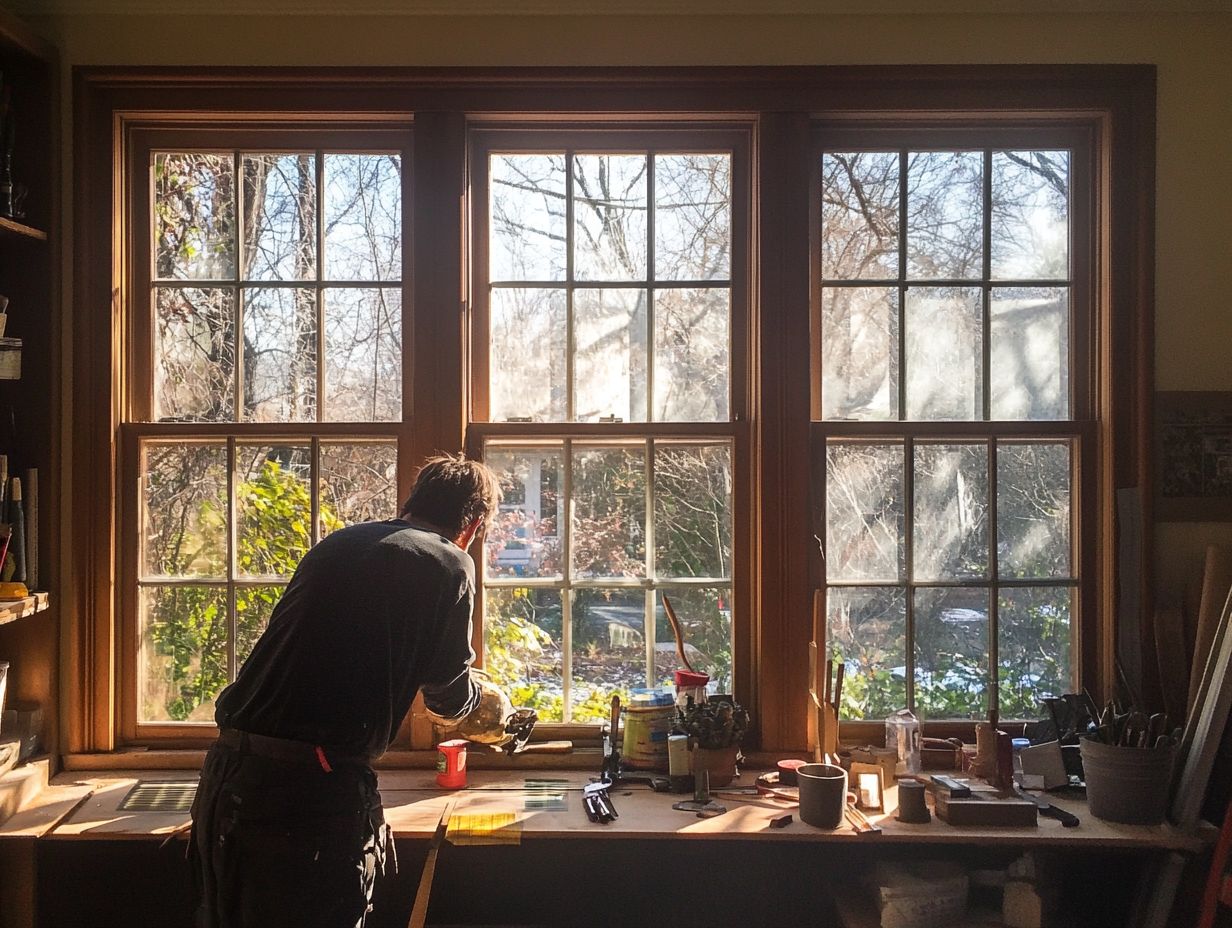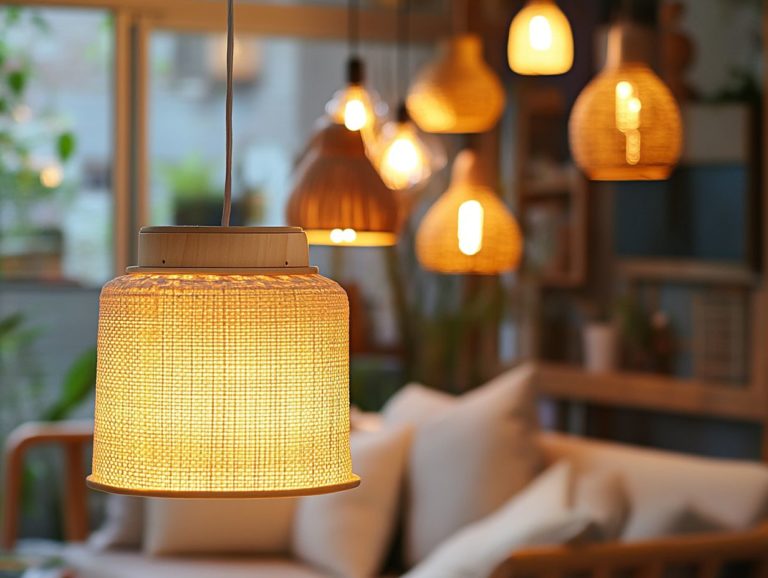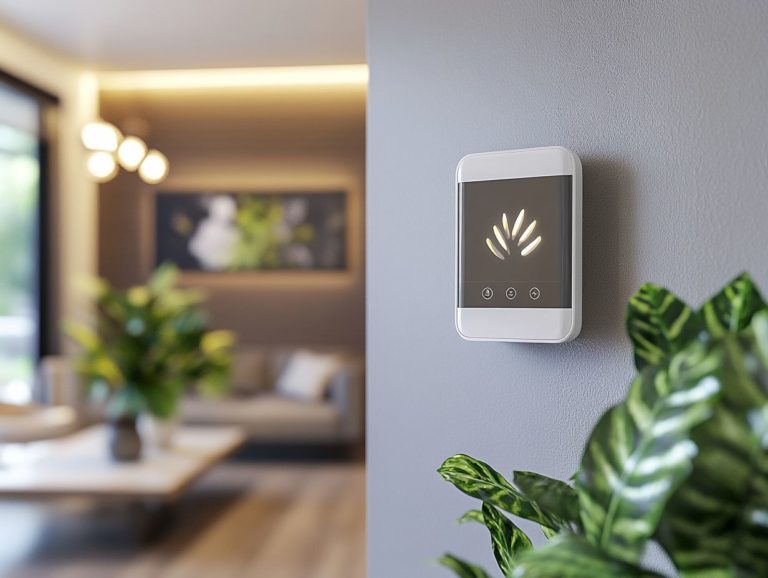DIY Energy Efficiency Upgrades for Older Homes
Older homes often radiate charm and character, yet they may not deliver on energy efficiency. Upgrading these residences is essential for enhancing your comfort, cutting down on utility bills, and minimizing your environmental footprint.
This article invites you to explore practical steps for assessing and improving your home’s energy efficiency. You’ll find straightforward DIY upgrades, effective insulation techniques, and tips to optimize your heating, ventilation, and air conditioning (HVAC) system. Additionally, you ll learn how to select energy-efficient lighting and appliances and implement small changes that can lead to significant benefits.
Get ready to unlock amazing energy savings for your home!
Contents
- Key Takeaways:
- The Importance of Energy Efficiency in Older Homes
- Assessing Your Home’s Energy Efficiency
- Transform Your Home with DIY Energy Upgrades!
- Insulation and Sealing
- Heating and Cooling Systems
- Lighting and Appliances
- Additional Tips for Energy Efficiency in Older Homes
- Frequently Asked Questions
- 1. How can I improve the energy efficiency of my older home without breaking the bank?
- 2. What are some simple ways to reduce the energy consumption of my older home?
- 3. Is it worth it to invest in energy-efficient windows for my older home?
- 4. Are there any DIY upgrades specifically for older homes that may have unique energy efficiency challenges?
- 5. Can I receive any tax credits for making energy efficiency upgrades to my older home?
- 6. Is it necessary to hire a professional for energy efficiency upgrades or can I do them myself?
Key Takeaways:
- Regularly assessing and upgrading the energy efficiency of your older home can save you money on utility bills.
- Conduct simple DIY energy efficiency upgrades like insulating and sealing your home or upgrading to energy-efficient lighting and appliances.
- Even small changes, such as using LED light bulbs or installing a smart thermostat, can contribute to overall energy efficiency.
The Importance of Energy Efficiency in Older Homes
Energy efficiency in older homes is more than just a trend; it s a crucial element of living in an eco-friendly way that benefits you as a homeowner and the environment. Many historic homes built in earlier decades often lack modern energy-efficient features, necessitating significant upgrades to lower utility bills and improve indoor air quality. You can look to experts like Bob Vila for advice on modernizing while preserving historical architecture.
Implement strategies like energy check-ups and insulation enhancements, along with installing HVAC systems and energy-efficient appliances rated by the Environmental Protection Agency. These steps maximize your comfort while simultaneously reducing your carbon footprint.
Embracing sustainable technologies like solar panels, heat pumps, and smart thermostats can pave the way for considerable long-term cost savings.
Why Upgrades are Necessary
Upgrading older homes for energy efficiency is essential, especially considering the outdated construction methods and materials that lead to soaring utility bills and compromised indoor comfort. Organizations like the National Association of Homebuilders advocate for such upgrades.
As energy costs continue to rise, you’ll become increasingly aware of the financial and ecological significance of modernizing your living space. Beyond just saving money, urgent environmental factors drive the need for upgrades; inefficient homes contribute to excessive energy consumption, which harms the planet. Consider exploring the best home improvement projects for energy saving to make a positive impact.
Government regulations are stepping in to encourage and sometimes mandate energy efficiency improvements. By conducting an energy check-up, perhaps with the help of companies like Duke Energy, you can identify areas that require upgrades, including how to make old homes more energy efficient, allowing you to prioritize the most impactful changes.
Common modifications like improving insulation, installing advanced HVAC systems, and using Energy Star appliances not only elevate your comfort and reduce expenses but also promote sustainability. For more detailed guidance, check out how to plan an energy-efficient home renovation to boost your property’s long-term value.
Assessing Your Home’s Energy Efficiency
To truly understand your home’s energy efficiency, start with a thorough energy audit. This detailed evaluation examines several factors affecting energy consumption, from air leaks to the quality of your insulation.
Start your energy efficiency journey today and see the difference it makes for your wallet and the planet!
Identifying Areas for Improvement
To improve your home s energy efficiency, inspect air leaks around doors and windows. Also, evaluate your insulation.
Companies specializing in historical architecture can provide techniques that blend with vintage aesthetics.
A thorough examination of potential energy loss can greatly benefit from thermal cameras, special cameras that show temperature differences and help you pinpoint where heat might be escaping. You can also conduct simple visual inspections to check for gaps or cracks, especially in older homes where weathering may have compromised seals.
Tackling these air leaks not only boosts your comfort but can lead to significant reductions in your utility bills. Don t wait to enhance your comfort start sealing those air leaks today!
Considering upgrades to energy-efficient windows and proper insulation can result in long-term savings. These enhancements create a more controlled indoor environment and reduce your dependence on heating and cooling systems. For more insights on improving your home’s efficiency, check out this guide on how to upgrade your home for energy efficiency. For example, using low-flow showerheads can help reduce water consumption, thereby lowering your overall utility expenses.
Transform Your Home with DIY Energy Upgrades!
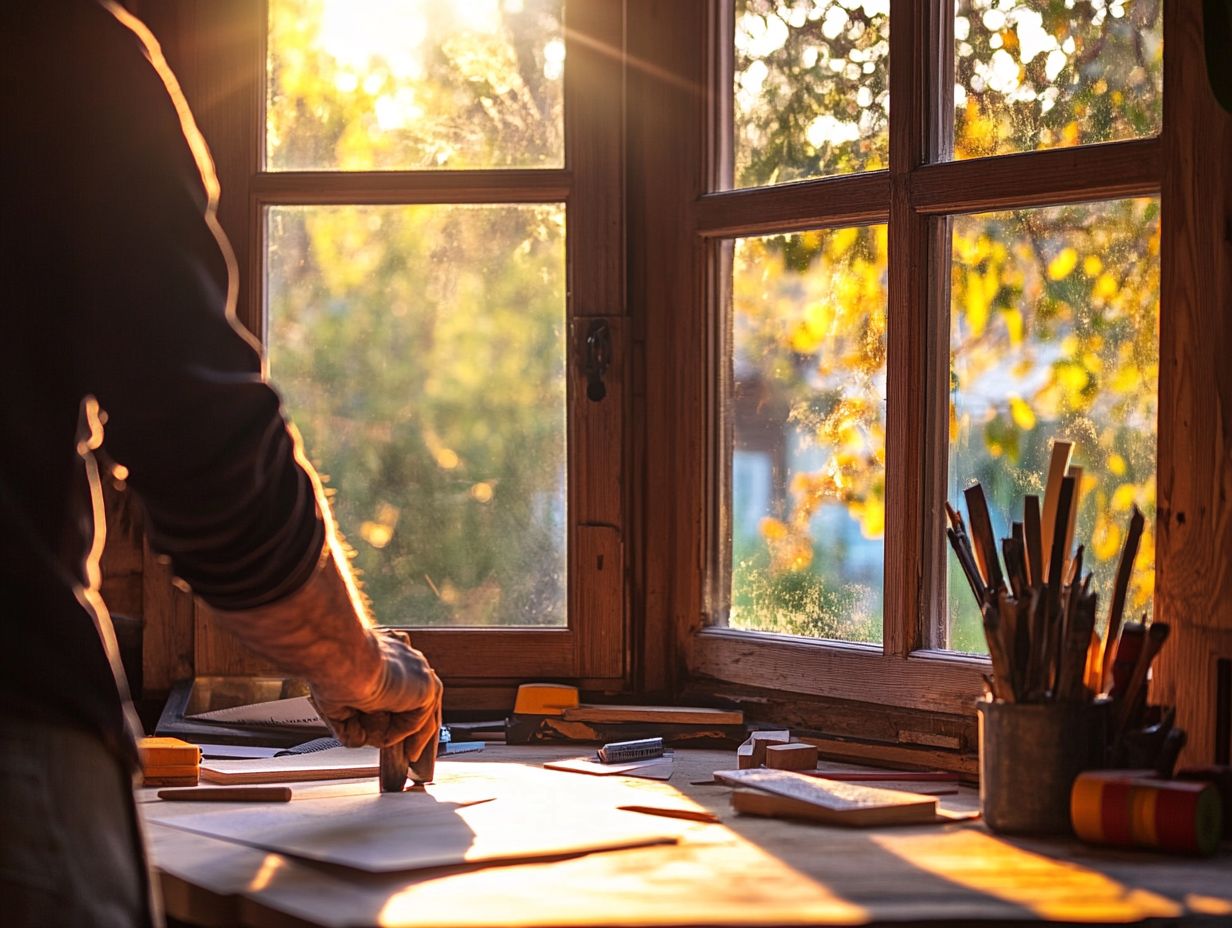
Embarking on DIY energy efficiency upgrades can be a game-changer for you. Not only are they cost-effective, but they also enable you to take control of your energy consumption while significantly reducing your utility bills. Check out Bob Vila s tips to unlock the secrets of energy efficiency upgrades!
Simple and Cost-Effective Solutions
You ll discover numerous simple and cost-effective solutions to enhance energy efficiency in older homes, all while preserving their charming vintage appeal and improving your comfort. Using caulk weatherstripping, for instance, can address many draft issues commonly found in older homes.
By focusing on strategic upgrades, you can significantly reduce your utility bills and create a more sustainable living environment. One particularly effective method is air sealing; by filling in gaps and cracks, you can prevent drafts and heat loss, leading to a cozier indoor atmosphere. For more tips, check out 5 ways to improve your home’s efficiency today.
Replacing outdated appliances with Energy Star-rated models not only offers substantial savings but also helps maintain the aesthetic integrity of your home. Additionally, opting for Energy Star appliances can help you curtail your carbon dioxide emissions.
Consider retrofitting vintage fixtures with modern technology, allowing you to enjoy the charm of your heritage while reaping the benefits of improved efficiency. These upgrades are often straightforward to implement, making sustainability an accessible goal for everyone. For example, many homeowners are incorporating top 10 energy-efficient home improvements like solar panels that blend seamlessly with their vintage homes.
Insulation and Sealing
Proper insulation and sealing are essential elements of energy efficiency that have a direct impact on the performance of your HVAC system and the overall comfort of your home. They are also critical for maintaining optimal indoor air quality by reducing the ingress of outdoor air pollutants.
By ensuring these components are effectively in place, you can significantly enhance your living environment while optimizing energy usage. Reducing air leaks and improving insulation helps stabilize indoor temperatures, contributing to long-term cost savings.
How to Properly Insulate and Seal Your Home
To effectively insulate and seal your home, begin by evaluating areas that are prone to heat loss, such as attics, basements, and crawl spaces. Use materials like caulk and weatherstripping to address any gaps you find. These methods are particularly effective in residential buildings where maintaining a consistent indoor climate is crucial.
By systematically examining these zones, you can pinpoint specific drafts and leaks that allow heated air to escape. Start with the usual suspects check around windows and doors where gaps are most common. Then move on to areas where pipes or wires penetrate walls. This approach aligns well with the practices recommended by energy-saving upgrades experts.
Once you’ve identified the problem spots, applying caulk is straightforward. Grab a caulk gun and fill in those cracks and crevices, ensuring you smooth it out for an airtight seal. For the edges where door or window frames meet the wall, consider using weatherstripping as an added layer of protection against air leaks. These steps are essential for reducing both energy consumption and costs.
Ready to take a big step? Upgrading to energy-efficient windows can significantly enhance these efforts. Not only do they minimize heat transfer, but they also contribute to long-term energy savings. This helps you maintain a comfortable indoor climate while reducing your reliance on heating and cooling systems. You could also consider installing low-flow shower heads to further cut down on water consumption.
Heating and Cooling Systems
Upgrading and maintaining your heating, ventilation, and air conditioning (HVAC) system is crucial for maximizing energy efficiency. An outdated system can significantly ramp up energy consumption, resulting in higher utility bills that can strain your finances.
Investing in a modern HVAC solution enhances comfort and takes a proactive step toward sustainability and cost savings. Integrating a heat pump can improve your system’s efficiency.
Tips for Upgrading and Maintaining HVAC Systems
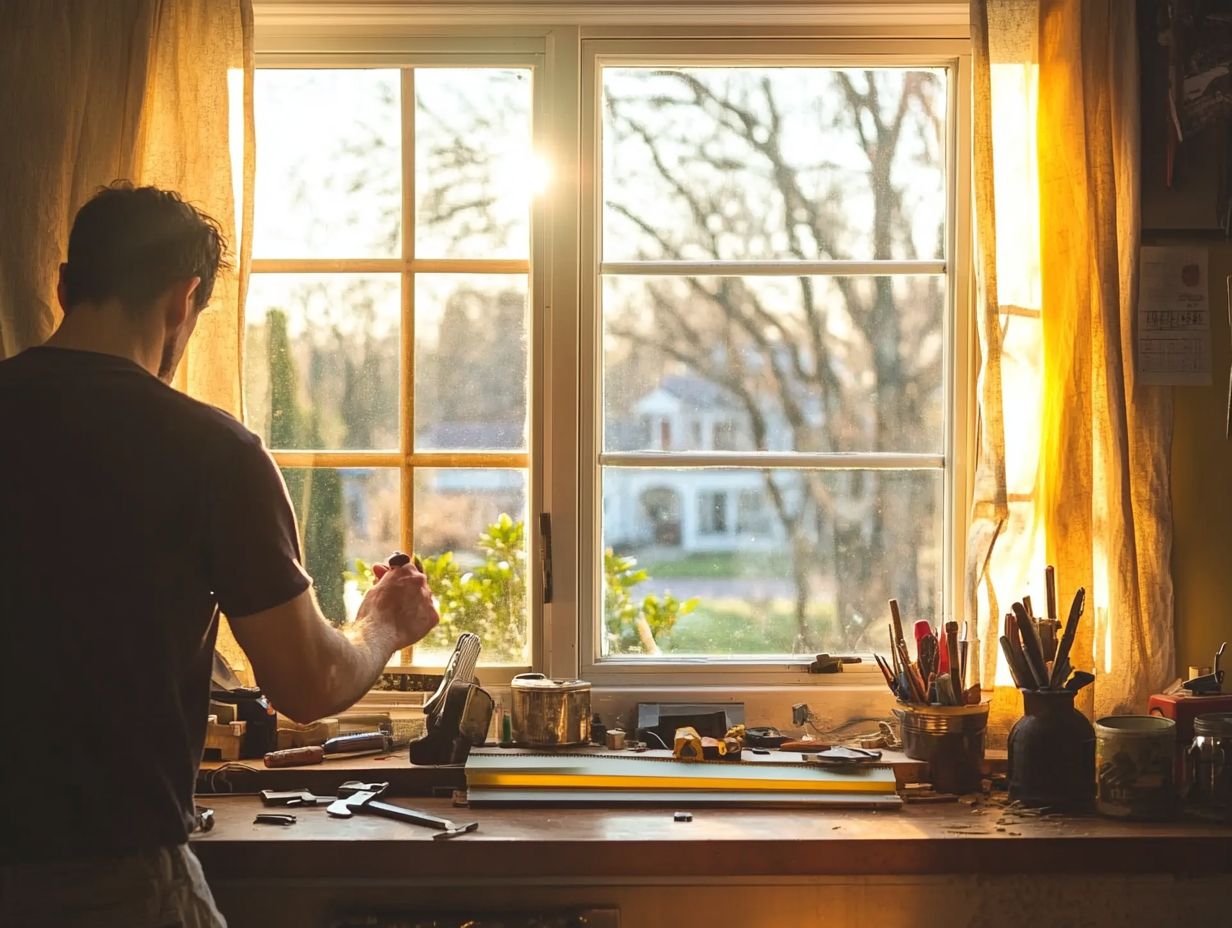
To ensure optimal performance, consider both upgrading your HVAC system and implementing effective maintenance tips that enhance energy efficiency.
Making informed choices about the right energy-efficient model can dramatically cut your utility bills while providing consistent comfort throughout your home. For instance, choosing a system with a high SEER rating (Seasonal Energy Efficiency Ratio) ensures better energy savings. Consulting with professionals from entities like the National Association of Homebuilders can guide you in making the best decisions for your specific needs.
Think about the advantages of installing smart thermostats, which allow for precise temperature control and scheduling that syncs with your daily routines.
Regular upkeep like changing filters monthly and scheduling professional inspections at least once a year can extend the life of your HVAC unit. This ensures it operates at peak efficiency and helps maintain good indoor air quality.
By committing to these strategies, you can enjoy a comfortable living environment while minimizing your environmental impact and costs.
Lighting and Appliances
Incorporating energy-efficient appliances and lighting solutions is essential to reduce energy consumption and lower utility bills, especially in older homes. Opt for Energy Star appliances to ensure maximum efficiency.
This thoughtful investment not only enhances your living space but also contributes significantly to a more sustainable environment.
Energy-Efficient Options for Lighting and Appliances
You have an array of energy-efficient options for lighting and appliances that can significantly elevate your home’s energy efficiency and comfort. Consulting resources like the Environmental Protection Agency can provide further guidance on effective choices.
Take LED bulbs, for instance. They consume only a fraction of the energy that traditional incandescent bulbs require. With their extended lifespan, you’ll find yourself replacing them far less often. Consider smart lighting systems as well. They allow you to control your lighting remotely and set personalized schedules, optimizing your usage based on your specific needs. For historic homes, using vintage lookalikes can be an aesthetically pleasing energy-efficient option.
Regarding appliances, opting for ENERGY STAR-rated models is a wise choice. These refrigerators, dishwashers, and washing machines are designed to operate with minimal energy consumption. Utilizing Energy Star appliances helps maintain low utility bills and promotes sustainable technology.
By incorporating these features into your daily life, you ll not only reduce your energy bills but also foster a more sustainable environment. Act now! Perform an energy audit a thorough assessment of your home s energy use to identify areas for improvement.
Additional Tips for Energy Efficiency in Older Homes
Implementing additional tips for energy efficiency can significantly enhance your home’s performance. This promotes sustainable living and effectively reduces running costs. Investing in insulation upgrades and addressing air leaks can vastly improve your home’s energy efficiency.
Small Changes That Can Make a Big Difference
Small changes, like installing low-flow showerheads or refining your laundry routine, can lead to remarkable improvements in energy efficiency and cost savings. Air sealing your home can prevent energy loss. Use caulk weatherstripping around drafty doors and windows.
By making simple adjustments such as switching to energy-efficient LED bulbs or sealing windows and doors to prevent drafts, you can significantly reduce your energy consumption over time. These seemingly minor alterations, when combined, not only lower your utility bills but also diminish your overall carbon footprint. For a deeper understanding of these benefits, consider exploring the cost benefits of energy efficiency upgrades. Embracing sustainable technologies like smart thermostats, solar panels, or a heat pump paves the way for a more eco-friendly lifestyle.
Adopting these practices instills a sense of responsibility toward the environment and can inspire those around you to follow your lead. This amplifies the positive impact on future generations. Monitoring market trends and advancements in energy-saving upgrades can further enhance your home’s efficiency.
Frequently Asked Questions

1. How can I improve the energy efficiency of my older home without breaking the bank?
You can make budget-friendly upgrades by sealing air leaks, adding insulation, and installing energy-efficient light bulbs. Conducting an energy audit provides insights into specific areas needing improvement.
2. What are some simple ways to reduce the energy consumption of my older home?
One of the easiest ways to reduce energy consumption is by adjusting your thermostat. Lowering it by just a few degrees in the winter and raising it in the summer can make a big difference. Unplugging electronics when not in use and switching to energy-efficient appliances also help. Installing a smart thermostat further optimizes your energy usage throughout the year.
3. Is it worth it to invest in energy-efficient windows for my older home?
While energy-efficient windows can be costly, they greatly improve the energy efficiency of your home. In the long run, they can save you money on heating and cooling costs, increase your home’s value, and improve its indoor air quality.
4. Are there any DIY upgrades specifically for older homes that may have unique energy efficiency challenges?
Yes, older homes often have drafty windows, insufficient insulation, and outdated heating or cooling systems. You can tackle these issues with DIY upgrades like weatherstripping, adding insulation, and upgrading to a more efficient heating system.
Installing energy-efficient windows and a heat pump also enhances energy savings significantly.
5. Can I receive any tax credits for making energy efficiency upgrades to my older home?
Yes, several tax credits are available for energy efficiency upgrades. These include the Residential Energy Efficient Property Credit and the Nonbusiness Energy Property Credit.
Check with your local government for additional incentives or rebates. Utility companies like Duke Energy also offer incentives for specific energy-efficient upgrades.
6. Is it necessary to hire a professional for energy efficiency upgrades or can I do them myself?
Some upgrades require a professional, but many DIY options exist for improving energy efficiency in older homes. For larger projects or safety concerns, it s wise to consult a professional.
Resources like Bob Vila and the National Association of Homebuilders provide valuable tips for tackling energy-efficient projects.

